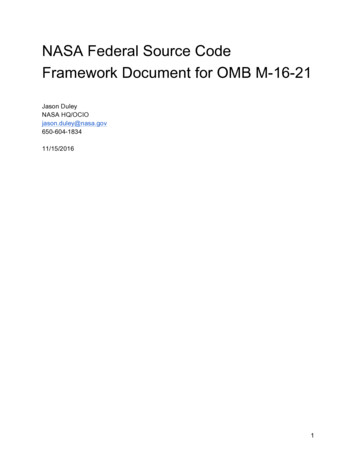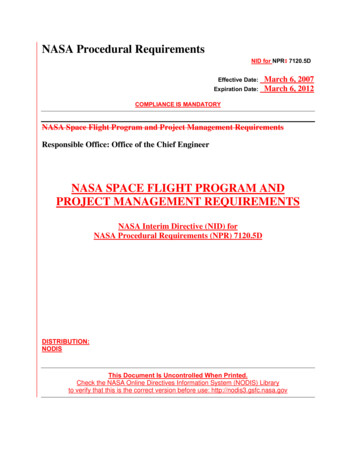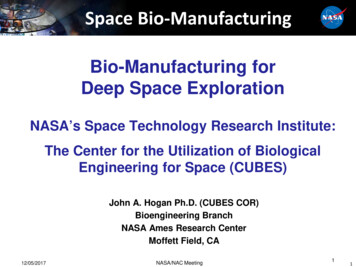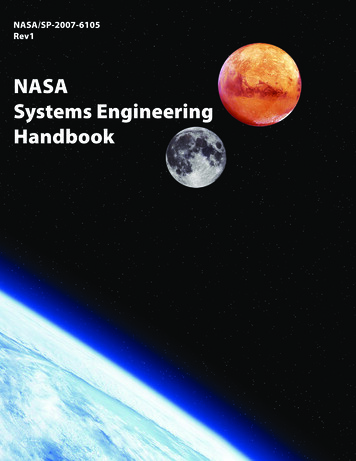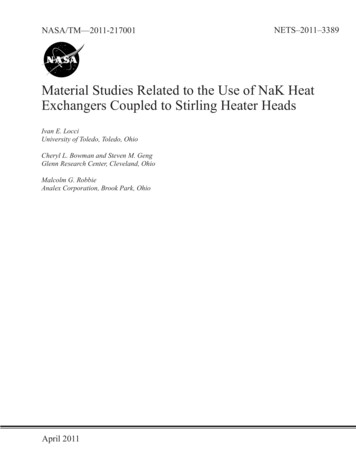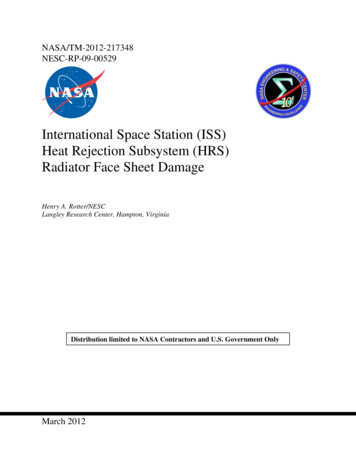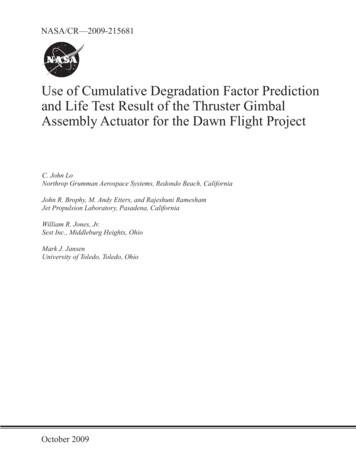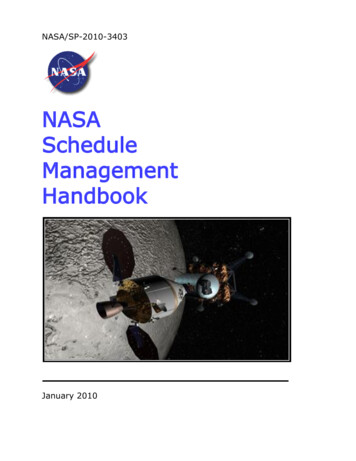
Transcription
1IidIReprinted fromPLANETARY ANDSPACE SCIENCEIPERGAMONOXFORDLONDON0PRESSNEW YORKPARIS-4
Planet. Space Sci. 1963, Vol. 11, pp. 485 to 498. Pergamon Press Ltd. Printed in Northern Ireland-'*'/,L .if63f'L/BS-'ffgDIRECT CONTACT AMONG GALACTIC CIVILIZATIONSBY RELATIVISTIC INTERSTELLAR SPACEFLIGHT*Abstract-An estimate of the number of advanced technical civilizations on planets of otherstars depends on our knowledge of the rate of star formation; the frequency of favorably situated planets; the probabilities of the origins of life, of intelligenceand of technical civilization;and the iifetimes of technicai civilizations. These parameters are poorly known. The estimatesof the present paper lead to -lo6 extant advanced technical civilizations in our Galaxy. Themost probable distance to the nearest such community is then several hundred light years.Interstellar spaceflightat relativistic velocities has several obvious advantages over electromagnetic communication among these civilizations. One striking feature is that with uniform acceleration of 1g to the midpoint of the journey, and uniform deceleration thereafter, all pointsin the Galaxy are accessible within the lifetime of a human crew, due to relativistic time dilation.Some of the technical problems in the construction of starships capable of relativistic velocitiesare discussed. It is concluded that with nuclear staging, fusion reactors, and the Bussard interstellar ramjet, no fundamental energetic problems exist for relativistic interstellar spaceflight.We assume that there exists in the Galaxy a loosely integrated community of diverse civilizations, cooperating in the exploration and sampling of astronomical objects and theirinhabitants. If each such advanced civilization launches one interstellar vehicle per year, themean time interval between samplings of an average star would be lo5 years, that betweensamplings of a planetary system with intelligent life would be IO' years, and that betweensampling of another advanced civilization would be lo3 years. It follows that there is thestatistical likelihood that Earth was visited by an advanced extraterrestrial civilization at leastonce during historical times. There are serious difficulties in demonstrating such a contactby ancient writings and iconography alone. Nevertheless, there are legends which mightprofitably be studied in this context. Bases or other artifacts of interstellar spacefaring civilizations might also exist elsewhere in the solar system. The conclusions of the presentpaper are clearly provisional.INTRODUCTIONIIn recent years there has been a resurgence of interest in the ancient speculation thatcivilizations exist on other worlds bzyond the Earth. This question has retained a basicand widespread appeal from the beginnings of human history; but only in the past decadehas it become even slightly tractable to serious scientific investigation. Work on stellarstatistics and stellar evolution has suggested that a large fraction of the stars in the skyhave planetary systems. Studies of the origin of the solar system and of the origin of thefirst terrestrial organisms have suggested that life readily arises early in the history offavorably-situated planets. The prospect occurs that life is a pervasive constituent of theuniverse. By terrestrial analogy it is not unreasonable to expect that, over astronomicaltimescales, intelligence and technical civilizations will evolve on many life-bearing planets.Under such circumstances the possibility then looms that contact with other galacticcommunities may somehow be established.It has been argued that the natural channel for interstellar communication is radioemission near the 21 cm line of neutral hydrogen'l); or between 3.2 and 8.1 cm(2); or ati?da-4*Based on an address delivered to the/American Rocket Society, 17th Annual Meeting Los Angeles,r. - I J15 November 1962.7Department of Astronomy, Harvard Uviversity, and Smithsonian Astrophysical Observatory,Cambridge, Massachusetts, U.S.A.485.7
486CARL SAGAN10.5 m ( Alternatively,).laser modulation of the intensity of core reversal in the Fraunhoferor automatic interstellar probe vehicleslines of late-type stars has been uggested' );transmitting a precoded message to planetary sources of monochromatic radio emissionwhich are randomly en ountered' ).The purpose of the present paper is to explore the likelihood and possible consequencesof another communications channel: direct physical contact among galactic communitiesby relativistic interstellar spaceflight. Part of the impetus for publishing these remarks hasbeen a paper by von H e r n e r 'which ) arrives at very pessimistic estimates for the number ofextraterrestrial civilizations; and three paper ( .'. ) which reach distinctly negative conclusions on the ultimate prospect of relativistic interstellar spaceflight. I feel that theinformation now available permits rather different conclusions to be drawn.The line of argument to be pursued involves a number of parameters which are onlypoorly known. The discussion is intended to stimulate further work in a number of disciplines.The reader is invited to adopt a skeptical frame of mind, and to modify the conclusionsaccordingly. Only through extensive discussion and experiment will the true outlinesgradually emerge in this enigmatic but significant subject.2. DISTRIBUTION OF TECHNICAL CIVILIZATIONS IN THE GALAXYWe desire to compute the number of extant galactic communities which have attained atechnical capability substantially in advance of our own. At the present rate of technological progress, we might picture this capability as several hundred years or more beyondour own stage of development. A simple method of computing this number is primarily dueto F. D. Drake, and was discussed extensively at a Conference on Intelligent Extraterrestrial Life held at the National Radio Astronomy Observatory in November, 1961, andsponsored by the Space Science Board of the National Academy of Sciences?. While thedetails differ in several respects, the following discussion is in substantial agreement withthe conclusions of the Conference.The number of extant advanced technical civilizations possessing both the interest andthe capability for interstellar communication can be expressed asN R*f&flf;feL.(1)R, is the mean rate of star formation averaged over the lifetime of the Galaxy, f, is thefraction of stars with planetary systems, ne is the mean number of planets in each planetarysystem with environments favorable for the origin of life,fi is the fraction of such favorableplanets on which life does develop,fi is the fraction of such inhabited planets on whichintelligent life with manipulative abilities arises during the lifetime of the local sun, fe isthe fraction of planets populated by intelligent beings on which an advanced technicalcivilization in the sense previously defined arises during the lifetime of the local sun, and Lis the lifetime of the technical civilization. We now proceed to discuss each parameterin turn.Since stars of solar mass or less have lifetimes on the main sequence comparable tothe age of the Galaxy, it is not the present rate of star formation but the mean rate of starformation during the age of the Galaxy which concerns us here. The number of knownstars in the Galaxy is -loll, most of which have mass equal to or less than the Sun. Theage of the Galaxy is -lolo years. Consequently, a first estimate for the mean rate of starformation is -10 stars/year. The present rate of star formation is at least an order off Attending this meeting were D. W. Atchley, M. Calvin, G. Cocconi, F. D. Drake, S. S. Huang, J. C.Lilly, P. M. Morrison, B. M. Oliver, J. P. T. Pearman, C. Sagan and 0. Struve.
DIRECT CONTACT AMONG GALACTIC CIVILIZATIONS487magnitude less than this figure, and the rate of star formation in early galactic history ispossibly several orders of magnitude more(g). According to present views of stellar nucleogenesis‘l0), stars (and, by implication, planets) formed in the early history of the Galaxyare extremely poor in heavy elements. Technical civilizations developed on such ancientplanets would of necessity be extremely different from our own. But in the flurry of earlystar formation when the Galaxy was young, heavy elements must have been generatedrapidly and later generations of stars and planets would have had adequate endowments ofhigh mass number nuclides. These very early systems should be subtracted in our estimateof R,. On the other hand, a suspicion exists that large numbers of low mass stars mayexist to the right of the main sequence ir. the Hertzsprung-Russell diagiaid’l’. Inclusionof these objects will tend to increase our estimate of R,. For present purposes we adoptR, IO/yr.!near spectra! vpc F5y; stars ofThere is a discontiniiity in st !!ar r n t & r ? :e! &eslater spectral type have very slow equatorial rotation rates. This circumstance is generallyattributed to the transfer of angular momentum from the star to a surrounding solar nebulaby magnetic c o p l i n g ‘ l ” , ,The’ , solar ) . nebula is then expected to condense into a planetarys y t e m ( J ,The ’ fraction * ) . of stars of later type than F5V is greater than 0.98; wellover 60 per cent of these are dwarf M stars(lg). It is not known what influence the luminosityof the star has on the subsequent condensation and dissipation of the surrounding solarnebula. We might expect that stars of much earlier type than the Sun readily dissipatetheir solar nebulae; and that stars of much later type than the Sun dissipate very little oftheir solar nebulae, thereby forming large numbers of massive planets of the Jovian type.There is good evidence that many of the chemical processes in the early history of the solarsystem occurred at low temperature(l’), and the low luminosity of late type stars is unlikelyto impede condensation processes in the solar nebula. We therefore adopt f, 1.Planets of double and multiple star systems are expected in general to have-overastronomical timescales-such erratic orbits that the evolution of life on them is deemedunlikely(20). I fail to find this argument entirely convincing; but for conservative reasonsit will be included in the discussion. The fraction of stars which are not members of doubleor multiple systems is 0*S21).In our own solar system the number of planets which arefavorably situated for the origin of life is at least two (Earth and Mars), and the possibilitythat life arose at some time on the Jovian planets(22’has recently been raised. It issometimes argued that life cannot develop on planets of M dwarfs, because the luminosity ofthe local sun is too small. However, especially for Jovian type planets of M dwarfs, thegreenhouse effect in a methane-ammonia-water atmosphere should produce quite reasonabletemperatures. We adopt ne 0.5 x 2 1.The most recent work on the origin of life strongly suggests that life arose very rapidlyduring the early history of the Earth(22-25).I t appears that the production of selfreplicating molecular systems is a forced process which is bound to occur because of thephysics and chemistry of primitive planetary environments. Such self-replicating systems,situated in a medium filled with replication precursors, satisfy all the requirements fornatural selection and biological evolution. Given sufficient time and an environmentwhich is not entirely static, the evolution of complex organisms is apparently inevitable.In our own solar system, the origin of life has probably occurred at least twice. We adoptfi1.The question of the evolution of intelligence is a difficult one. This is not a field whichlends itself to laboratory experimentation, and the number of intelligent species available----
CARL SAGAN488for study on Earth is limited. Intelligent hominids have inhabited the Earth for fofEarth history.It is clear that the evolution of intelligence and manipulative ability has resulted fromthe product of a large number of individually unlikely events. If the history of the Earthwere started again, it is highly improbable that the same sequence of events would recurand that intelligence would evolve in the identical manner. On the other hand, the adaptivevalue of intelligence and manipulative ability is so great-at least until technical civilizationsare developed-that, if it is genetically feasible, natural selection is very likely to bringit forth. There is some evidence that surprisingly high levels of intelligence have evolvedin the Cetacea(26). Phylogenetically, these are rather close to hominids; the neuroanatomyof Cetacea brains is remarkably similar to that of the primates, although the most recentcommon ancestor of the two groups lived more than 108 years ago(26).The Cetacea havevery limited manipulative abilities.Comparison of the rates of stellar and of biological evolution provides some perspectiveon the probability that intelligence will arise on an otherwise suitable planet. Terrestrialintelligence and civilization have emerged roughly midway in the Sun's residence time onthe main sequence. The overwhelming majority of stars in the sky have longer lifetimesthan the Sun. With the expectation that the Earth is not extraordinary in its recent evolutionbut allowing for the fact that apparently only one intelligent phylogenetic order withmanipulative abilities has developed, and this only recently, we adopt fiN 10-l.Whether there is one, or several, foci for the line of cultural development which has ledto the present technical civilization on Earth is still an open question, depending in part onthe extent of cultural diffusion over large distances some five or six thousand years in thepast. It appears that little can be gained from speculation on, e.g. whether Aztec civilizationwould have developed a technical phase had there been no Conquistadores.of the period in whichRecorded history-even in mythological guise-covers Gof geological time. The same conthe Earth has been inhabited by hominids, and Gsiderations are involved as in the determination of fi.The development of a technicalcivilization has high survival value at least up to a point; but in any given case it dependson the concatenation of many improbable events; and it has occurred only recently interrestrial history. It is unlikely that the Earth is very extraordinary in possessing a technicalcivilization among planets inhabited by intelligent beings. As before, over stellar evolutionary timescales, we adoptf, ,- 10-l.The multiplication of the preceding factors givesN 10 x 1X1X1X10-1 X 10-1XL 10-lL.L is the mean lifetime in years of a technical civilization possessing both the interest and thecapability for interstellar communication. For the evaluation of L there is-fortunatelyfor us, but unfortunately for the discussion-not even one known terrestrial example. Thepresent technical civilization on Earth has reached the communicative phase (in the senseof high-gain directional antennas for the reception of extraterrestrial radio signals) onlywithin the last few years. There is a sober possibility that L for Earth will be measured indecades. It is also possible that international political diffcrences will be permanentlysettled, and that L may be measured in geological time. It is conceivable that, on otherworlds, the resolution of national conflicts and the establishment of planetary governmentsare accomplished before weapons of mass destruction become available. We can imaginetwo extreme alternatives for the evaluation of L : (a) a technical civilization destroys*4
DIRECT CONTACT AMONG GALACTIC CIVILIZATIONS489itself soon after reaching the communicative phase (L lo2 years); or (b) a technicalcivilization learns to live with itself soon after reaching the communicative phase. If itsurvives lo2 years, it will be unlikely to destroy itself afterwards. In the latter case itslifetime may be measured on a stellar evolutionary timescale (L los) years. Such asociety will exercise self-selection on its members; genetic changes will be unable to movethe species off the adaptive peak of the technical civilization. The technology will certainlybe adequate to cope with tectonic and orogenic changes. Even the evolution of the localsun through the red giant and white dwarf evolutionary stages may not pose insuperableproblems for the survival of an extremely advanced community.It seems improbable that, surrounded by large numbers of fleurishing and diversegalactic communities, a given planetary civilization will retreat from the communicativephase. This is one reason that L is itself a function of N . Von H e r n e r ' has ) suggestedanother reason: he feels that the means of avoiding se!f-destructicx !vi! be am ng theprimary contents of initial interstellar communications.has talked of the possibility that interstellar space voyagers accidentally maybioiogicaily contaminate lifeless planets, and thereby initiate the origin of life. There isalso some prospect that such initiation might be purposefully performed. In these cases.f, f i ( N ) . Below we will discuss the possibility that fc f , ( N ) . For these reasons itshould be remembered that equation (1) is in reality an integral equation.The two choices for L ( lo2 years and 3 108 years) lead to two values of N : 10 communicative technical civilizations per galaxy, or 10'. Thus the evaluation of N dependsquite critically on our expectation for the lifetime of the average advanced community.Von H e r n e r ' has) made very pessimistic estimates for L, and his values of N are correspondingly small. It seems more reasonable to me that at least a few per cent of theadvanced technical civilizations in the Galaxy do not destroy themselves, nor lose interestin interstellar communication, nor suffer insuperable biological or geological catastrophies,and that their lifetimes, therefore, are measured on stellarevolutionary timescales. Averagedover all technical civilizations, we therefore take L lo7 years. For the purposes of thefollowing discussion then, we adopt as the steady-state number of extant advanced technicalcivilizations in the Galaxy :N - 106.NThus, approximately 0.001 per cent of the stars in the sky will have a planet upon whichan advanced civilization resides. The most probable distance to the nearest such communityis then several hundred light years."3. FEASIBILITY OF INTERSTELLAR SPACEFLIGHTThe difficulties of electromagnetic communication over such interstellar distances areserious. A simple query and response to the nearest technical civilization requires periodsapproaching 1600 years. An extended conversation-or direct communication with aparticularly interesting community on the other side of the Galaxy-will occupy muchgreater time intervals, lo4 to lo5 years.Electromagnetic communication assumes that the choice of signal frequency will beobvious to all communities. But there has been considerable disagreement about interstellartransmission frequency assignment even on our own planet(1*2*3*4,5); among galactic communities, we can expect much more sizable differences of opinion about what is obvious* In the Space Science Board Conference previously mentioned, the conclusions for N spanned 104-10e,and the distance to the nearest advanced community ranged from ten to several thousand light years.
490CARL SAGANand what is not. No matter how ingenious the method, there are certain limitations on thecharacter of the communication effected with an alien civilization by electromagneticsignalling. With billions of years of independent biological and social evolution, thethought processes and habit patterns of any two communities must differ greatly; electromagnetic communication of programmed learning between two such communities wouldseem to be a very difficult undertaking indeed. The learning is vicarious. Finally, electromagnetic communication does not permit two of the most exciting categories of interstellarcontact-namely, contact between an advanced civilization and an intelligent but pretechnical society, and the exchange of artifacts and biological specimens among the variouscommunities.Interstellar space flight sweeps away these difficulties. It reopens the arena of actionfor civilizations where local exploration has been completed; it provides access beyondthe planetary frontiers.There are two basic methods of achieving interstellar spaceflight within characteristichuman lifetimes. One involves the slowing down of human metabolic activities during verylong flight times. In the remainder of the paper, we will discuss relativistic interstellar spaceflight, which, in effect accomplishes the identical function, and further, permits the voyagerto return to his home planet in much shorter periods of time, as measured on the homeplanet.If relativistic velocities can be achieved, time dilation will permit very long journeyswithin a human lifetime. Consider a starship capable of uniform acceleration to themidpoint of the journey, and uniform deceleration thereafter. The relativistic equations ofmotion have been solved by Peschka(28)and by Sanger(29).For our flight plan, their resultsare readily modified, and yield for the time t, as measured on the space vehicle, to travel adistance S, with a uniform acceleration a to S/2 and a uniform deceleration -a thereafter:t (242) arc cosh (1aS/2c2)(2)where c is the velocity of light. The results for such an acceleration-deceleration flightplan are shown in Fig. 1 .At an acceleration of 1 g-as would be appropriate for inhabitants of a planet of terrestrial mass and radius-it takes only a few years shiptime to reach the nearest stars,21 years to reach the Galactic Center, and 28 years to reach the nearest spiral galaxy beyondthe Milky Way. With accelerations of 2 or 3 g-as would be appropriate for inhabitantsof a planet of Jovian mass and radius-these distances can be negotiated in about half thetime. Of course there is no time dilation on the home planet; the elapsed time in yearsapproximately equals the distance of the destination in light years plus twice the time toreach relativistic velocities. For distances beyond about ten light years, the elapsed timeon the home planet in years roughly equals the distance of the destination in light years.Thus, for a round trip with a several-year stopover to the nearest stars, the elapsed timeon Earth will be a few decades; to Deneb, a few centuries; to the Vela Cloud Complex,a few millenia; to the Galactic Center, a few tens of thousands of years; to M31, a fewmillion years; to the Virgo Cluster of Galaxies, a few tens of millions of years; and to theComa Cluster, a few hundreds of millions of years. Nevertheless, each of these immensejourneys could be performed within the lifetimes of a human crew. For transgalactic andintergalactic distances, equation (2) reduces tot 2c/a In (aS/c2)(3)and in this range the curves of Fig. 1 are straight lines on a semi-logarithmic plot.
DIRECT CONTACT AMONG GALACTIC CIVILIZATIONS49 1A number of difficulties have been presented by early authors on the technical aspectsof relativistic interstellar spaceflight. Even with complete conversion of mass into energy,extreme mass ratios are required if all the fuel is carried at launch. For relativistic velocities and the above flight plan, the mass ratio is approximately equal to 2/ , where 4 1 - (v/c), and u is the maximum vehicle velo ity(7.30,3 ).For example, to reach u 0.999 c,the liftoff weight must be some 2000 times the payload, and it is clear that enormous initialvehicle masses are required. For the round trip with no refueling, the mass ratio is (2/ )2.Thus, A k e r e t ( concluded3 l)that “even with daring assumptions,” interstellar spaceflightat relativistic velocities would be feasible only for travel to the nearest stars. Furthermore,baryon charge conservation prevents the complete conversion of matter to energy, except108IIIi0.391Coma Cluster ofGalaxies/II07/ ‘//Virgo Cluster ofGalaxies -1Pleiades StarCluster (M45)Deneb (oCyg)Vega ( a Lyr)Eridani-Centaur1,L‘ 0I51015SO253Ship time t in years-,FIG.1if half the working fuel is antimatter(32);the containment of the antimatter-to say nothingof its production in the quantities required-is clearly a very serious problem. An additional difficulty with such an antimatter starship drive has been emphasized by Purcell”) ;the gamma ray exhaust would be lethal for the inhabitants of the launch planet if the drivewere turned on near the planet (and if atmospheric absorption is neglected). Staging offusion rockets(33)provides some relaxation of the required mass ratios, but it appears thatrelativistic velocities cannot be obtained by such staging alone.A way out of these difficulties has been provided by Bussard‘ ) in a most stimulatingpaper. Bussard describes an interstellar ramjet which uses the interstellar medium both
492CARL SAGANas a working fluid (to provide reaction mass), and as an energy source (by thermonuclearfusion). There is no complete conversion of matter into energy; the existing mass deficitsand low reaction cross-sections for the conversion of hydrogen to deuterium are used.The reactor is certainly not available today; but it violates no physical principles, it iscurrently being very actively pursued, and there is no reason to expect it to be more than afew centuries away from realization on this planet. The Bussard interstellar ramjet requires very large frontal area loading densities: -10-8 g cm-2 per nucleon m in- the interstellar medium. Thus, if the payload is lo9 gm, the intake area must have a radiusof -60 kin in regions where the interstellar density is as high as lo3 nucleons m - In.ordinary interstellar space, where the density is -1 nucleon m - the , intake area radiusmust be -2000 km. If the latter radius seems absurdly large, even projecting for theprogress of future technology, we can easily imagine the vehicle to seek trajectories throughclouds of interstellar material, and vary its acceleration with the density of the mediumwithin which it finds itself. Pierce(6)had earlier considered and rejected interstellar ramjets,but the rejection was based on much smaller intake areas than Bussard proposes.Of course the intake area may not necessarily be material; to the extent that the ramjetsweeps up ionized interstellar material magnetic fields could be used for collection. Starships would then seek trajectories through H I1 regions. The Bussard interstellar ramjetalso requires moderate liftoff velocities; but even presently-achievable liftoff velocities aslow as 1-10 km/sec would be adequate.Bussard does not discuss the method of funnelling the interstellar matter so it can becollected and utilized for propulsion. Indeed this is one fundamental problem which mustbe faced by any relativistic interstellar vehicle; otherwise the structural and biologicaldamage from the induced cosmic ray flux will prevent any useful application of the extremevelocities achieved. The maximum velocity of the vehicle in the rest frame, after coveringS/2, half the distance to the destination, at uniform acceleration a, is given(29s30)bYv c[l - (1aS/2c2)-']1'2.(4) Equation (4) is illustrated in Fig. 2 for the same three choices of a which have already beenused. The abscissa gives the maximum velocity reached, expressed as 1 - v/c, duringa half acceleration-half deceleration flight plan to a destination at distance S. For example,for a trip to Galactic Center, maximum velocities within IO-' toper cent of the velocityof light are required. Also shown in Fig. 2 are the velocities at which relative kineticenergies of 1 MeV, 1 BeV, and 1 erg are imparted to interstellar protons by the motion ofthe vehicle. For travel to even the nearest stars within a human shipboard lifetime,protection from the induced cosmic ray flux is mandatory. It is evident from the largemass ratios already required for boosted interstellar flight, and from the low frontal loadingarea surface densities required for an interstellar ramjet, that material shielding is probablynot a feasible solution.If some means of ionizing the impacting interstellar material could be found, the ionscan be deflected and captured by a magnetic fieId. In the case that trajectories through H IIregions are sought, the interstellar medium will be already largely ionized, and magneticfunnelling would be practicable. The configuration of the field would have to bedesigned very ingeniously, but the average field strengths required could be as low as a fewhundred gauss even for very long voyages. Much higher field strengths would be required,at least in the propulsion module, for a fusion ramjet; or alternatively for a containedplasma driving a photon rocket(3'). It appears likely that superconducting flux pumps(3s)
DIRECT CONTACT AMONG GALACTIC CIVILIZATIONS493can provide the magnetic field strengths required for deflection of the induced cosmic rayflux.Bussard’s(34)concluding remarks on the size of the frontal loading area and the magnitude of the effort involved in relativistic interstellar spaceflight are worth quoting: “Thisis very large by ordinary standards, but then, on any account, interstellar travel is inherentlya rather grand undertaking, certainly many magnitudes broader in scope and likewise more15cy5 I-”/cbFIG.2.difficult than interplanetary travel in the solar system, for example. The engineering effortrequired for the achievement of successful short-time interstellar flight will likely be as muchgreater than that involved in interplanetary flight as the latter is more difficult than travelon the surface of the Earth. However, the expansion of man’s horizons will be proportionately greater, and nothing worthwhile is ever achieved easily.”The purpose of this Section is to lend credence to the proposition that a combinationof staged fusion boosters, large mass-ratios, ramjets working on
intelligent life with manipulative abilities arises during the lifetime of the local sun, fe is the fraction of planets populated by intelligent beings on which an advanced technical civilization in the sense previously defined arises during the lifetime of the local sun, and L is the lifetime of the technical civilization.
